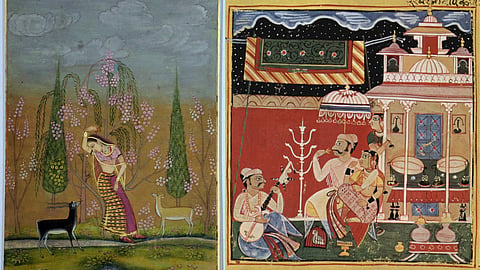
- HOMEGROWN WORLD
- #HGCREATORS
- #HGEXPLORE
- #HGVOICES
- #HGSHOP
- CAREERS
- ABOUT US
- CONTACT US

The whole world sings high praises of Western Classical music and rightly so, when you look at its rich history. However, Indian classical music possesses a rare jewel that has no equivalent in Western classical music — the ragas. The word raga has Sanskrit roots and literally translates to ‘color’. In northern India, it is referred to as rag and ragam in Southern India. A raga is a melodic framework for improvisation. In the Indian music tradition, each raga is an arrangement of melodic structures with musical motifs, believed to have the ability to "color the mind" and influence the emotions of the audience.
"There are approximately about 4 lakh raags in Hindustani Classical music. Many of them are repetitious but have different names."
Ustad Vilayat Khan, before beginning his performance at the Sawai Gandharva Bhimsen Festival, Pune
However, there are six main ragas, from which all other ragas are born — Bhairav, Hindol, Megh, Shri, Deepak, and Malkauns. Each raga has five wives (raginis) and eight sons (ragaputras). It is quite a patriarchal setting and is reflective of its times. The idea of ragas dates back to the Vedic days and one can find mentions of it in the Mukhya Upanishads and the Bhagavad Gita. There are emotional significances and associations of each raga with the time of the day, season, and moods. Each raga can evoke particular feelings within the listener with its own unique melodic personality.
Today, we have Spotify playlists for our different moods and activities — a pumped-up playlist for exercise, a different playlist when you’re feeling the blues, a whole other set when you’re on cloud nine, and several other unique playlists curated for your specific states of mind. But now you know that this classification is not an invention of millennials but dates back centuries to the Vedic days. There are also visual proofs of that in the form of raagmala paintings of the miniature school, that were inspired from the ragas.
Raagmala literally means a ‘garland of musical melodies’. 'Mala' means 'garland' and 'Raga', as we have discussed before, is a "distinct musical arrangement". Raagmala symbolizes a unique amalgamation of music and art, nourished across centuries, and commissioned by both Hindu and Muslim rulers. In the beginning, these paintings generally revolved around Hindu deities and later began to depict human emotions. One particularly recurring theme depicted in the paintings is the painful wait for one’s lover to return. With the foundation based on the same miniature school, the paintings evolved into distinct regional styles — Rajasthani, Deccan, and Pahadi.
The subjects of the paintings indicate the mood of the paintings. The use of colour is particularly important as it captures the time of the day or the season. Take a closer look at how the first two images depict yearning for the lover, but at different times of the day - the first, 'Vilaval', in the morning, and the second, 'Malashree', in the evening.
Other images, in order: 'Todi', 'Vasanta', 'Megha Malhar', and 'Sorathi'.
To put things more into perspective, lets examine a famous raagmala painting inspired from the Bhaskar ragaputra of Hindol. This Raga is sung at the break of dawn when the sun rises. One can spot Surya, the sun god mounted on his 7 headed horse, rising to a female offering a lotus petal. The temple and its empty walls indicate that it is very early and that no one else has woken up yet. The painting conveys a sense of tranquility that you feel early in the morning when the daily routine of life has not yet been set in motion.
The Dulwich Picture Gallery has an interesting video where the exhibition curator, Lizzie Watson further explores the painting. You can watch it below.
